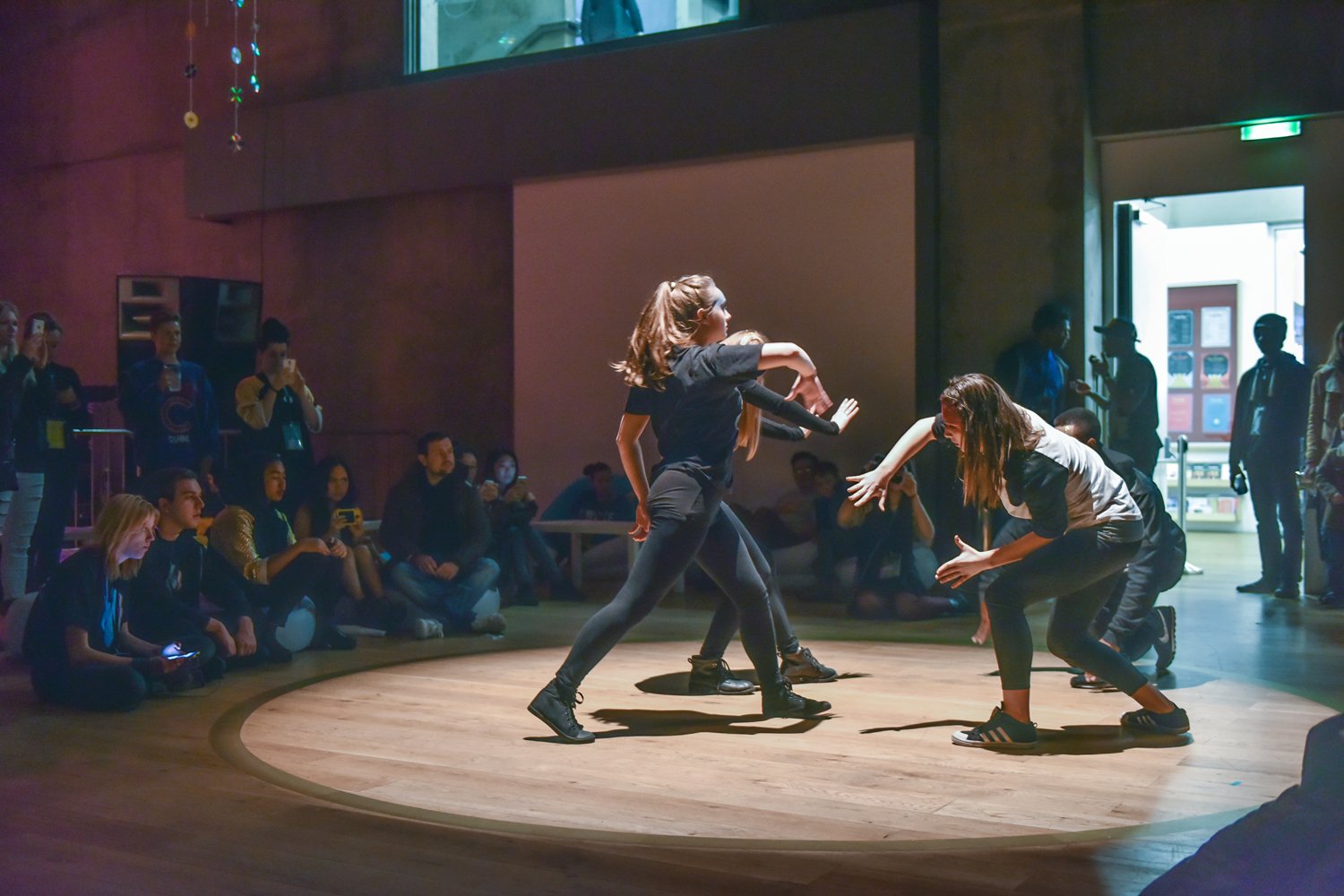
Circuit at Nottingham Contemporary’s Affinity festival
New decision-makers
Tate’s Circuit programme for young people has helped promote wider organisational understanding of the value of young people as cultural producers. Mark Miller reflects on its impact and highlights.
This year marks the conclusion of Circuit, a four-year project funded by Paul Hamlyn Foundation, that has connected a total of 135,000 young people aged 15 to 25 to the arts. It has given them a chance to influence organisations in a tangible way through peer-led activities, so that they move from the periphery to the centre of decision-making and programming in arts institutions.
The relevance of the programme to issues affecting young people and peer-led content has attracted them to it
Over the years, we have worked with partners from the Plus Tate network: Firstsite in Colchester; MOSTYN in Llandudno; Nottingham Contemporary; Whitworth Art Gallery in Manchester; and Wysing Arts Centre and Kettle’s Yard in Cambridgeshire. The young people in the network have devised and produced their own events and activities including ambitious festivals that have been attended by over 35,000 people.
Positive change
Circuit aimed to make a positive change in the cultural experiences and resources available for young people, particularly those who have the fewest opportunities to participate in galleries and museums. Many participants have maintained long-term relationships with the galleries through skills they have developed such as teamwork, event development, creative thinking, confidence and communication. They have also gained knowledge about galleries and employment in the cultural sector through art, digital platforms, live music and film, as well as working with exhibitions and displays.
Peer-led content and the relevance of the programme to issues affecting young people has attracted them to it. Circuit has enabled young cultural producers to establish more diverse audiences across all the galleries, with 22 as the average age of those taking part, and around a quarter from BAME backgrounds.
A conference, ‘Test, Risk, Change’, at Nottingham Contemporary examined the impact of Circuit. It produced a day of lively and provocative debate involving 165 project participants and representatives from organisations across the youth and cultural sector. The event explored how the arts and youth sectors can work together effectively in turbulent social and political times. The open discussions highlighted many tensions relating to organisational hierarchies and change, and the need for a long-term strategic approach to resources and programming.
Project highlights
Highlights of the project include the following:
- Firstsite’s peer-led group YAK (Young Art Kommunity) built a programme around gaming, street dance, sound and digital and produced Flipside festival that took over the gallery for two weeks last autumn.
- Kettle’s Yard and Wysing Arts’ Circuit Cambridge ran the Unlock Cambridge festival that involved events across the city and beyond.
- MOSTYN established its first young people’s group, GLITCH. The Plaza was an exhibition curated by and with the gallery’s GLITCH Collective, involving a skate park constructed inside the gallery.
- Nottingham Contemporary’s Collabor-8 Collective produced the Affinity festival.
- The Whitworth Young Contemporaries co-produced WARP Festival across the park and the galleries for the reopening last year of the gallery following refurbishment.
- Tate Collective London produced events in response to Tate Modern and Tate Britain’s collection and exhibitions and curated large-scale events such as the Late at Tate Britain events. Tate Liverpool, delivered the Blue Print festival, and Art Gym exhibition, which combined interactive workshops with artist-led events.
- A highlight of the Tate St Ives programme was the SWITCH festival, involving local community artists, performances, young people’s exhibitions and digital projections across the town.
Tate Collectives
Tate’s well-established group for young people, Tate Collectives, now has over 100 members who contribute to developing programmes across Tate London, Tate Liverpool and Tate St Ives, all operating under the Circuit umbrella.
Tate Collective London curates and helps to produce Late at Tate Britain events, regularly attended by around 3,000 people. Young people also led Fresh Perspectives, public tours at Tate Modern, enhancing their skills in public speaking and learning how to create accessible content, as well as supporting large-scale events such as Future Medina, part of Tate Exchange.
A beneficial role
There has been a significant shift at directorial and organisational level in support for and understanding of the purpose and value of the role young people can play in the sector.
We should also remember what has been accomplished during the insecure times of Brexit, austerity and cultural-sector budget cuts over the past four years, which have contributed to social and political uncertainty.
Some Circuit galleries began the programme without consistent practice or programme provision for young people as autonomous contributors to their organisations and have developed significant progression. Those that had established practices have pushed their provision even further, enabling wider organisational awareness and understanding of the value of young people as cultural producers.
Though significant work is required to enable a balanced representation of ethnicity and socio-economic backgrounds in galleries, we have found that young people, more generally, are struggling to engage with the cultural sector due to the current UK economic and education landscape. Our long-term approach has enabled support, progression routes, professional insight and experience for young people.
Mark Miller is National Lead and Convenor of Circuit.
circuit.tate.org.uk
The full research outcomes and recommendations from Circuit will be published this autumn with a view to producing a long-term legacy and sectoral change.
Join the Discussion
You must be logged in to post a comment.